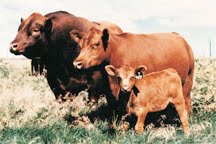A study published in this month’s Journal of Animal Science found that raising a pound of beef in the United States today uses significantly fewer natural resources, including land, water, feed and fuel than in the past. “The Environmental Impact of Beef Production in the United States: 1977 compared with 2007” (Journal of Animal Science, December 18, 2011) by Jude Capper, Ph.D., Washington State University, documents that each pound of beef raised in 2007 used 33 percent less land, 12 percent less water, 19 percent less feed and 9 percent less fossil fuel energy than equivalent beef production in 1977. Waste outputs were similarly reduced, shrinking the carbon footprint of beef by 16.3 percent in 30 years.
According to Capper’s research, improvements in the way cattle are raised and fed in the United States between 1977 and 2007 yielded 13 percent more total beef from 30 percent fewer animals. Raising more beef from fewer animals maximizes natural resources while providing essential nutrients for the human diet. As the population increases, it is crucial to continue the improvements demonstrated over the past 30 years to meet demand for nutrient-rich beef while reducing resource use and mitigating environmental impact. Turning back the clock on these advancements is not the solution to feeding a world population that recently reached 7 billion and will grow to 10 billion by the year 2050, concludes the author.
“As the number of mouths to feed increases and the quality of diets in many areas around the world improves, the demand for nutrient-rich protein like beef will increase,” says Capper. “At the same time, resources like land, water and fossil fuels will become increasingly scarce. These realities are like two trains speeding toward each other on the same track. If we listen to alarmists shouting at us to slow down, we could face a head-on collision of epic proportions. The only way to avoid this disaster is to accelerate the pace of progress.”
Capper attributes much of the reduction in beef’s environmental footprint to raising cattle on grass pasture before finishing them on an optimal balanced diet of grasses, grains and other forages in a feedyard. According to previous research conducted by Capper, each pound of grain-finished beef requires 45 percent less land, 76 percent less water and 49 percent less feed and at the same time generates 51 percent less manure and 42 percent fewer carbon emissions than grass-finished beef.
“As we work on solutions for the future it is important to understand how far the U.S. livestock industry has come in reducing its environmental footprint in the recent past and how this significant reduction was achieved,” says Capper. “The facts are in. Improved cattle diets in the feedyard and responsible use of science-based technologies to improve the ability of cattle to convert feed to pounds of beef, reduces the amount of land, water and fossil fuels it takes to raise beef. “
Capper says focusing resources to provide more nutrient rich foods like beef, which provides more than 10 percent of the daily recommended value of ten essential nutrients and vitamins for less than ten percent of daily calories (based on a 2,000 calorie per-day diet), is a critical success factor in meeting nutrition needs at home and abroad.
”Making the best use of resources like land, water and energy to raise nutrient-rich beef is the key to sustainability,” says Capper. “The result is delicious, healthful beef you can feel good about.”
This project was supported by the Beef Checkoff Program through a research grant from state beef councils in Iowa, Kansas, Nebraska, South Dakota and Washington.
Learn more about your beef checkoff at
The Red Angus History
RED HIDE COLOR HAS THREE DISTINCT ADVANTAGES:

"1)Red is the most populous color of cattle breeds world wide. Red Angus provides a continuity and uniformity of color to any crossbreeding system. 2) Red is more heat tolerant than black and the bronze pigmentation gives great resistance to cancer eye and sun burned udders. The majority of the world’s cattle are in areas that need heat tolerance, so the red color is a definite advantage. 3) Being crossed red always breeds true. Red Angus carry no diluter genes and thus avoid the grays that result when crossbreeding with blacks." Follow this link and click History Brochure to read complete history.
Thursday, December 22, 2011
Thursday, December 15, 2011
Tuesday, November 8, 2011
Tuesday, October 4, 2011
Power of Protein
Read the entire article by following the link.
Beef Nutrition Facts
Red meat's fat profile is often misunderstood and a common misperception is that animal proteins provide only saturated fat. Surprisingly, half the fat in beef is monounsaturated, the same type of heart-healthy fat found in salmon and olive oil. In addition, one-third of the saturated fat in beef is stearic acid, which studies have shown has a neutral or cholesterol-lowering effect.
the Idaho Beef Council
Tuesday, August 30, 2011
Federal judge overturns grazing ban on Idaho land Rebecca Boone, Associated Press | Updated: July 28, 2011
A federal judge has overturned a ban on livestock grazing on some public lands in southern Idaho, saying that limited grazing may actually benefit the land by reducing fuels for wildfires.
U.S. District Judge B. Lynn Winmill's ruling last week said grazing permit holders can continue to graze livestock in 17 allotments of the U.S. Bureau of Land Management Jarbidge Resource Area.
The practice has long been a contested practice in the Jarbidge Resource Area, with opponents contending that livestock damage crucial habitat for imperiled sage grouse and trample the endangered plant slickspot peppergrass. Grazing permits in the region have been the subject of lawsuits and in March, Winmill suspended grazing on the 17 allotments.
But on Friday, the judge said he'd been swayed by the testimony of experts on both sides who said the decline in sage grouse populations is largely the result of wildfires. A huge blaze in 2007 burned more than 400,000 acres in the Jarbidge Resource Area, destroying 70 percent of the area's sage grouse habitat, Winmill noted.
The judge said he now believed that careful grazing could help protect the land by reducing the number of plants that could fuel wildfires, stopping or at least slowing down the flames.
For complete story follow the link below.
.http://www.cattlenetwork.com/cattle-news/Federal-judge-overturns-grazing-ban-on-Idaho-land--126325528.html?ref=528
U.S. District Judge B. Lynn Winmill's ruling last week said grazing permit holders can continue to graze livestock in 17 allotments of the U.S. Bureau of Land Management Jarbidge Resource Area.
The practice has long been a contested practice in the Jarbidge Resource Area, with opponents contending that livestock damage crucial habitat for imperiled sage grouse and trample the endangered plant slickspot peppergrass. Grazing permits in the region have been the subject of lawsuits and in March, Winmill suspended grazing on the 17 allotments.
But on Friday, the judge said he'd been swayed by the testimony of experts on both sides who said the decline in sage grouse populations is largely the result of wildfires. A huge blaze in 2007 burned more than 400,000 acres in the Jarbidge Resource Area, destroying 70 percent of the area's sage grouse habitat, Winmill noted.
The judge said he now believed that careful grazing could help protect the land by reducing the number of plants that could fuel wildfires, stopping or at least slowing down the flames.
For complete story follow the link below.
.http://www.cattlenetwork.com/cattle-news/Federal-judge-overturns-grazing-ban-on-Idaho-land--126325528.html?ref=528
Sunday, July 10, 2011
Colorado Cattlemen Beat WWP
Idaho Cattle Association.The Executive Update is a weekly newsletter sent to members of the Idaho Cattle Association.http://www.idahocattle.org/
The Colorado Cattlemen‘s Association (CCA), the U.S. Forest Service, the Chaffee County Board of Commissioners, and thirteen livestock producing families this month prevailed against a lawsuit filed by Western Watersheds Project (WWP). In 2009, CCA and Chaffee County joined ranchers in protecting their right to multiple-use grazing of public lands by intervening in a lawsuit filed by the anti-livestock grazing WWP, which sought to deny renewal of grazing in the Pike and San Isabel National Forests.
According to a CCA press release, the appeal by WWP objected to the renewal of the grazing permits, claiming that the decision violated the Forest Plan in various ways including wildlife protection, protecting soil productivity, protecting water quality, and protecting archaeological resources. The decision to renew had in fact been approved after a thorough environmental review. The Forest Service grazing decision also incorporated adaptive management principles to improve environmental conditions in the forests. The ranchers and the Forest Service worked together to develop management steps that would address resource issues and still be cost-effective. Upon reviewing the briefs and the administrative record, the court affirmed the decision of the Forest Service and allows continued livestock grazing under the adaptive management that everyone committed to do.
This ruling is very helpful in the greater fight against extremist groups as they continually file lawsuits with similar claims to those of WWP. The victory is also a testament to the great job CCA has done along with their members in collecting monitoring data to defend grazing decisions in the face of court challenge.
Sunday, July 3, 2011
Red Angus plays a strong role in profitable ranching
Cattlemen across the nation are recognizing the role genetics play in increasing both quality and profitability of their cowherds. Breeders and industry professionals who attended the annual BrainTrust meeting in Denver, Colo., held during the National Western Stock Show, discussed the direction of the beef cattle industry and Red Angus’ impact on profitability.
For complete story follow this link
For complete story follow this link
Idaho JR. Beef Expo
| Lady |
There was at least eight head of Red Angus at the Expo this year; the most in the barn in this area that I have seen, and who know maybe one of these day we will have A Red Angus Class; as for this year we had to show in the all other breeds class.
| Lady |
| Fabio |
| Fabio |
It was nice to see other Red Angus there. I wish I would have interview the young lady showing her cattle; but I guess hind sight is 20-20 I will make a point of that next time There is Red Angus in the barn. Just so you know they had some beautiful Heifers at the show.
Sorry Haun Family these are the only pictures I got.
Wednesday, June 1, 2011
Thursday, May 26, 2011
Cattlemen care: Idaho’s beef industry unites against hunger
Cattlemen care: Idaho’s beef industry unites against hunger
It’s no secret that cattle producers have generous hearts, and one program that is clearly showcasing this is Beef Counts, the first-known program of its kind that provides a means for Idaho’s beef producers to assist less-fortunate consumers right in their own backyards.
Described by the Idaho beef industry as a multi-faceted public relations and community-help campaign, Beef Counts brings together all of Idaho’s beef industry in partnership with the Idaho Foodbank, to provide nutrient-rich beef to help end hunger in Idaho.
Read the compete story follow this link
Read the compete story follow this link
Thursday, May 19, 2011
Beef Cattle and the Quest for Knowledge (Beef Production Medicine and Management)
I love to read; I truly believe that knowledge is power.
While on this quest for knowledge; last week I had a book dropped in my lap that I have not put down.
The title of this book is BEEF Production Medicine and Management; in section A; you can read about Anatomy, Biosecurity, Body condition Scoring, Nutrition, Normal ranges for temperature, heart and resporatory rates, showing junior livestock, prescription and non-prescription drug guidelines and the list goes on this is just section A.
Section B - Routine Observation and Procedures.
Section C - Vaccines and Parasite Control Products.
Section D - Tests and Diagnostics.
Section E - Flowcharts for Specific Symptoms.
Section F - Infectious Diseases, Problems and Treatment.
If you are in 4-H, FFA, or a cattle producer this is a book you should own. I have to return this one soon, but I have order my own and it will be here soon.
this book is a Animal Health Publications you can order it on line or call 1-877-424-7838.
There is also manuals for;
Horses
Sheep and Goats
Beef and Dairy
Dogs and Cats
I think the next one that I will get will be the one for Horses. before I am done I hope to own all of them because my animal never seem to get sick on a week days.
Follow the links and check it out for yourself; KNOWLEDGE IS POWER.
While on this quest for knowledge; last week I had a book dropped in my lap that I have not put down.
The title of this book is BEEF Production Medicine and Management; in section A; you can read about Anatomy, Biosecurity, Body condition Scoring, Nutrition, Normal ranges for temperature, heart and resporatory rates, showing junior livestock, prescription and non-prescription drug guidelines and the list goes on this is just section A.
Section B - Routine Observation and Procedures.
Section C - Vaccines and Parasite Control Products.
Section D - Tests and Diagnostics.
Section E - Flowcharts for Specific Symptoms.
Section F - Infectious Diseases, Problems and Treatment.
If you are in 4-H, FFA, or a cattle producer this is a book you should own. I have to return this one soon, but I have order my own and it will be here soon.
this book is a Animal Health Publications you can order it on line or call 1-877-424-7838.
There is also manuals for;
Horses
Sheep and Goats
Beef and Dairy
Dogs and Cats
I think the next one that I will get will be the one for Horses. before I am done I hope to own all of them because my animal never seem to get sick on a week days.
Follow the links and check it out for yourself; KNOWLEDGE IS POWER.
Monday, May 2, 2011
Beef Understanding What you are Buying and Eating
Today I went to the Bates Custom Butchers and graded my two remaining steers.
 Cindy Kinder the Extension Educator for Gooding County was my teacher.
Cindy Kinder the Extension Educator for Gooding County was my teacher.
To grade my beef we measured the size of the rib eye, back fat, and figure the kph fat, and you must have the carcass weight.
These two beef graded prime minus and choice plus.
Grades are based on the amount of marbling in the meat and the age of the animal. Marbling is the flecks and streaks of white fat you find distributed throughout the meat. In general, the higher the degree of marbling, the more tender, juicy, and flavorable the meat will be. Higher grade meats come at a higher cost.
Beef is best in flavor and texture when cattle are between 18 and 24 months old, so the grading favors younger animals.
Meat graders assign a yield grade to a carcass by evaluating:
There are eight distinct grades of beef recognized by the USDA.
Just over half of the beef graded each year earns a grade of Choice.
USDA. In order of descending quality they are:
I got all my information from
http://meat.tamu.edu/beefgrading.html
http://www.bbqreport.com/archives/barbecue/2006/03/02/understanding-the-usda-beef-grading-system/
for more information click the links above.
To grade my beef we measured the size of the rib eye, back fat, and figure the kph fat, and you must have the carcass weight.
These two beef graded prime minus and choice plus.
Grades are based on the amount of marbling in the meat and the age of the animal. Marbling is the flecks and streaks of white fat you find distributed throughout the meat. In general, the higher the degree of marbling, the more tender, juicy, and flavorable the meat will be. Higher grade meats come at a higher cost.
Beef is best in flavor and texture when cattle are between 18 and 24 months old, so the grading favors younger animals.
Meat graders assign a yield grade to a carcass by evaluating:
- the amount of external fat;
- the hot carcass weight;
- the amount of kidney, pelvic, and heart fat; and
- the area of the ribeye muscle.
There are eight distinct grades of beef recognized by the USDA.
USDA Prime Beef
- is the ultimate in tenderness, juiciness, and flavor.
USDA Choice Beef
Choice grade beef has less marbling than Prime, but is still of very high quality. This is the most popular grade of beef because it contains sufficient marbling for taste.Just over half of the beef graded each year earns a grade of Choice.
USDA Select beef
This is generally a lower priced grade of beef with less marbling than Choice. Select cuts of beef may vary in tenderness and juiciness.USDA. In order of descending quality they are:
- Prime
- Choice
- Select
- Standard
- Commercial
- Utility
- Cutter
- Canner
I got all my information from
http://meat.tamu.edu/beefgrading.html
http://www.bbqreport.com/archives/barbecue/2006/03/02/understanding-the-usda-beef-grading-system/
for more information click the links above.
Wednesday, March 30, 2011
I Have Been Giving This Some Thought
I am not sure if the majority of the American Consumers really understands the impact that the loss of BLM ground for grazing will have on their personal and financial lives.
Once upon a time Buffalo roamed the plains. Sadly, this is no longer true; but when they did roam, they grazed and in the search for food, they also cut large paths that acted as firebreaks. The thundering herds of Buffalo did not harm the environment; the fact is that they worked the ground with their hoofs and grazed off vegetation that later in the summer would become a fire hazard. The grazing off of this vegetation in now done by cattle and other livestock, their hoofs now work the ground and stimulate the new growth of vegetation that not only feeds the livestock the following spring but the wild game during the winter months.
Wildfires happen it is just part of nature; the fact is that the cattle graze off the fuel that feeds these wildfires, which in turn saves wildlife habitats, and the scenic beauty that we have all grown to expect. Wildfires cost the American taxpayers millions of dollars per year to put them out. The loss of grazing permits means you as taxpayers will have to foot the bill for not only putting out the fire but also the lost trees, vegetation and habitats.
Ranchers and cattlemen are great environmentalist. We as American consumers need them and the wildlife needs them. After a wildfire, the cattle and livestock still need to be fed, watered and cared for; to meet the needs of their cattle, or livestock. These hard working souls (rancher, cattlemen) work to return the burnt out BLM ground to it natural state, clean water ways so that they run freely, and reseed vegetation usually at their own expense; this is done to not only to feed their livestock; but also to repair the wildlife habitats.To be a true Stewart (environmentalist) of the land you have to get your hands dirty.
Ranchers, Cowboys, Cattlemen live and breath their lifestyle; they are not on a vacation their way of life is hard work. The one perk that they do have is the beauty of the great outdoors, even though it comes with extremely hot summers and very cold winters.
Ranchers, Cowboys, Cattlemen live and breath their lifestyle; they are not on a vacation their way of life is hard work. The one perk that they do have is the beauty of the great outdoors, even though it comes with extremely hot summers and very cold winters.
As I said; Buffalo once roamed; how sad it will be if generations to come say, once upon a time there were Cowboys/Cowgirls, Ranchers, and Cattlemen/Cattlewomen.
Remember that food we eat does not grow on the grocery store shelves.
Keep America strong let us eat what we grow; Look for the Country of Origin on the label.
That’s my opinion and story and I am sticking to it.
Tuesday, March 22, 2011
Cattlemen, Ranchers, Farmers, Are the Backs on which This Country was Built
Cattlemen, Ranchers, Farmers are in my opinion a soft spoken, hard working, breed. Most spend their days from sun up to long after the sun goes down seven days a week twelve months a year working alone; So when they do speak I found that I better be listening.
Here lately these hard work souls have been being attacked by some who would like to but them out of business. Here are a few videos you won't see on the Evening News. If they go out of business we as a Nation will most likely go hungry.
Subscribe to:
Posts (Atom)









